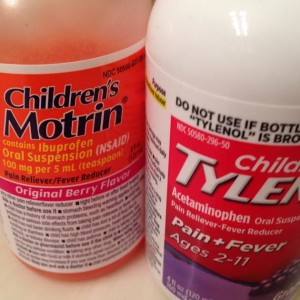
It might be common practice in your household to reach for the Tylenol or ibuprofen when your child is sick to keep them comfortable and reduce pain associated with illness…but hold on. Newer guidelines from the American Academy of Pediatrics now urge parents to recognize fevers as a a sign the immune system is working to fight off an illness. Fevers are generally not harmful in and of themselves, and the generally accepted consensus is that even fevers as high as 103 degrees do not need to be “normalized” to a lower temperature. Though cold and flu season is finally wrapping up for 2016, here are a few guidelines on when you should and shouldn’t treat a fever, to keep your kids (and everyone around them!) healthy year-round.
Reasons to Avoid Fever Reducers
Fever reducers can increase viral shedding, meaning the sick/infected child is spreading higher concentrations of the virus that is making them sick, for a longer period of time. Increased viral shedding can increase the odds of getting another family member, caretaker or friend infected with the same virus – the more you are spreading around, the greater the likelihood is that someone else will pick it up. Fevers are an evolutionary defense that helps to reduce the amount of virus in a sick person’s body – as the temperature rises, it becomes less hospitable for the germs and viruses that are making you sick. Your body tissues, on the other hand, are remarkably resilient.
The commonly cited fever threshold is 103 degrees, but it’s rare for untreated fevers to climb over 105. Damage to the brain generally does not occur until 107. In a small percentage of children (about 2-5% under the age of five) fevers exceeding 101 can trigger a febrile seizure, which while frightening, do not cause long-term health problems or indicate a more serious condition such as epilepsy. If your child’s fever begins to climb over 103 degrees you can use some of the self-care measures outlined below to help reduce the body’s temperature without medication.
Help the body heal with self-care measures rather than medications to mask symptoms. To reduce a child’s temperature without medication, dress your child in thin, light layers and apply cool, wrung out washcloths to their forehead and neck. You can also place a child in a tepid, shallow bath and let them play for a bit until their temperature cools down. Cool water, ice, fruit juice popsicles and chilled rehydrating solutions will keep your child hydrated, helping them to heal faster. The medicinal powers of chicken soup are being medically documented, and rest is always prescribed to help your body as it fights off an illness.
Despite the reasons not to reduce a fever with medicine, pain- and fever-reducing medicines such acetaminophen and ibuprofen are still useful in a parent’s medicine cabinet. If your child is so uncomfortable they cannot get adequate sleep or rest it is more than appropriate to give medication to help ease their symptoms, but realize a fever itself does not have to be “treated.” Consult with your family doctor or pediatrician about how best to treat common colds in your home and always remember to seek care when it becomes necessary. If you want more information on when you should/should not medicate a fever Wellness Mama has written an excellent article on the topic.
Here’s wishing you a happy and healthy Spring!

Leave a Reply